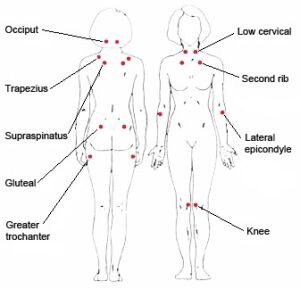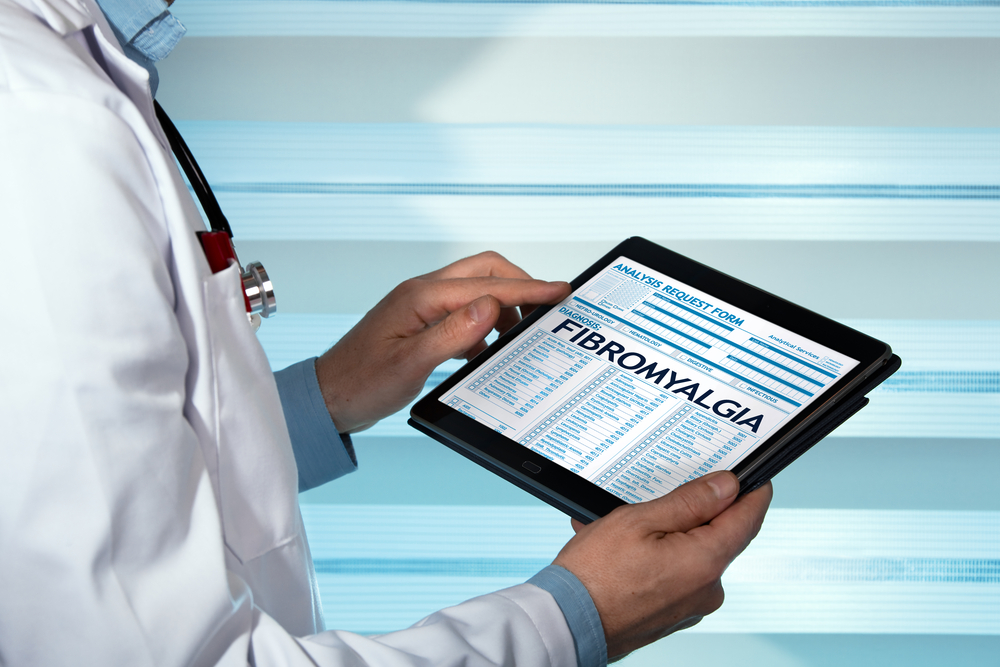What are Fibromyalgia Tender Points?
Fibromyalgia tender points are small spots of pain located around different areas on the body that hurt when pressed on. These are sometimes confused with trigger points, but there is a difference between the two. Trigger points are knots that you can actually feel in your muscles. When pressure is applied to these, pain can radiate out along meridians or nerves.
With tender points, the pain doesn’t radiate. However, people afflicted with Fibro can also have trigger point pain that coincides with tender point pain. In fact, The American Pain Society states that most tender points are also trigger points. It can be confusing especially since the terms used to describe the symptoms are so similar.
There are nine pairs of tender points established by the American College of Rheumatology:
- Lower front neck muscles
- Chest just beneath the collar bone
- Muscles on the back of the neck under the skull
- Top of the shoulder muscles along the curve of the neck
- Back of the shoulders along the top of the shoulder blades
- Outer creases of the elbows
- Outer tops of the buttocks
- Outside hip area
- Pads of the inner knee
It is not known what causes these particular areas to be so painful. It is well established though that tender spots are a consistent symptom in those suffering from Fibromyalgia.
Tender points are small but can, in some cases, be excruciatingly painful to the touch or when pressure is applied. In 1990, the American College of Rheumatology (ACR) established that 11 of the 18 points needed to be painful in order for a Fibromyalgia diagnosis to be given. Not everyone feels pain in an exact number of tender points at any given time however. Fortunately, the guidelines for diagnosis changed in 2010, and again in 2016. To see the specific 2016 guidelines, click HERE: https://www.sciencedirect.com/science/article/pii/S0049017216302086?via%3Dihub
Diagnosis of Fibromyalgia
While a diagnosis of Fibromyalgia may still include testing for the presence of tender points, they are no longer considered a requirement. Fibro is a syndrome that is a group of symptoms. To determine if someone has Fibromyalgia, the medical community mainly considers pain being the main symptom, along with extreme fatigue, and cognitive problems with memory and concentration.
There is also an objective test that can be used for diagnosis called the FM/a® test which is available through a company called EpicGenetics. Though it’s been around since 2012 and is FDA approved, many physicians are not using it at this time because it is expensive and not necessarily needed to diagnose Fibromyalgia. It has gained media attention recently and that may be because funding has been secured for a large drug study to be completed for Fibromyalgia at the University of Massachusetts. One of the requirements for the study is that the patients undergo this test before participating. It will be interesting to see what develops from this long-term study in terms of a Fibromyalgia cure.
Triggers That Exacerbate Tender Points Pain Levels
- Lack of sleep
- Weather changes
- Physical exhaustion
- Infections and/or illness
- Changes in hormones such as PMS
- Not enough physical activity
- Emotional stress
Treatment for Pain
The number one long-term treatment for pain for people who have Fibromyalgia is exercise. This seems like an oxymoron because who wants to exercise when they’re in pain? The key for Fibro sufferers is to start slow. I recommend just starting with stretching, which can help alleviate some immediate pain. Then see if you can follow this with low impact exercises such as walking, yoga, swimming, or elliptical-type exercise. Don’t push too hard and don’t give up.
I personally swim and use the Elliptical machine. On days when you are flaring or really exhausted, listen to your body and rest. Some days you might only spend 10 minutes exercising and other days try to go longer. It’s also helpful to split workouts into segments throughout the day. If you can do some physical activity for 5 minutes at a time and do it 4 or 5 times throughout the day, then that still counts as a good 20-30 minutes.
What I have found to be true though is that exercise does help. It gives me more energy when I do it consistently and makes me feel better overall. Daily stretching also helps tremendously.
Other Remedies
Some people find that Acupuncture provides relief. Studies have shown that massage therapy is an excellent way to decrease pain levels and I find that to be true as well.
Trigger point injections may help in more severe cases but those must be administered by a trained pain specialist. They can contain a local anesthetic or steroids and are only a temporary fix.
CBD oil is also indicated to be a particularly effective treatment for pain. It can be taken orally or topically as an ointment (or both may be used). This can be a bit tricky based on the state that you live in because THC (the chemical found in Marijuana that affects the mind) is only legal in some states. However, not all CBD oil contains THC, and studies have shown that it is still quite effective with pain relief. To read more about the details of this study, click HERE: https://www.ncbi.nlm.nih.gov/pmc/articles/PMC3728280/
We all know that the pain we experience from Fibromyalgia comes in many shapes and forms. It is important to exercise, eat right, and rest. Those three things alone can go a long way in providing relief and remission. But everyone is unique and feels their pain differently. I hope you will try some of the things I’ve suggested and that it helps you!







